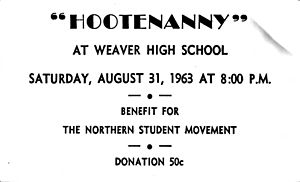Northern Student Movement facts for kids
| Founded | 1961 |
|---|---|
| Founder | Peter J. Countryman |
| Dissolved | 1966? |
| Type | Civil rights organization |
| Focus | Tutoring 3,500 inner city youth in northeastern cities (1963); later sent students to sit-ins in the South and organized direct-action protests in the North. |
| Location | |
| Origins | Conference of the New England Student Christian Movement (1961) |
| Method | Volunteerism, education, community organizing |
|
Key people
|
Peter J. Countryman William L. Strickland |
|
Employees
|
50 (1963) |
|
Volunteers
|
2,200 (1963) |
The Northern Student Movement (NSM) was an American group that worked for civil rights. It was inspired by student protests in the southern United States. NSM started at Yale University in 1961. Peter J. Countryman founded it. The group was connected to the Student Nonviolent Coordinating Committee (SNCC).
Countryman first collected books for Black colleges. He also raised money for SNCC. Then, he started tutoring programs. These programs helped young people in cities in the Northeast. By 1963, NSM helped about 3,500 children. They had 2,200 student volunteers from 50 colleges. NSM also supported direct protests. They sent volunteers to sit-ins in the South. They also organized rent strikes in the North. In the early 1960s, NSM focused on three main areas. These were campuses, communities, and the South.
What Was the NSM?
Peter J. Countryman, a white student at Yale, helped create the NSM in 1961. The NSM's main goals were to support SNCC's work. They also wanted to fight against unfair treatment in the North. The Northern Student Movement soon began projects in northern communities. These projects aimed to fight injustice in Black neighborhoods.
Countryman stopped being the NSM's leader in 1963. William L. Strickland took over his role.
Early Projects and Help
The NSM started tutoring and community programs. These were in segregated and poor city areas in the North. In Boston, NSM helped people register to vote. They also ran preschool programs. They even had workshops on Black history. In Philadelphia, they opened a "freedom library." This library had books by and about Black people.
The NSM had 50 full-time staff members. They also had about 2,200 to 2,500 college student volunteers. These students focused on helping communities. They tutored students. They also started the North End Community Action Project. This project organized protests against unfair hiring.
The Northern Student Movement also focused on local organizing. Later, many felt that Black people should lead their own communities. So, the NSM shifted to become an all-Black organization. Bill Strickland, the second leader, led many efforts. These included rent strikes and school boycotts. He also helped with community projects.
Later Years and Changes
A NSM volunteer named Bruce Payne was shot in Mississippi. He was helping with a voter registration campaign. This event led Dr. Martin Luther King Jr. to visit Yale University. He wrote a letter to the Yale chaplain. In it, he said he was "heartened by the movement in the right direction I sense at Yale."
The NSM became less active later in the 1960s. Black students began to protest for changes on campuses. They wanted police removed from campuses. They also wanted forgiveness for striking students. They pushed for Black studies courses, like those NSM had started.
Images for kids



